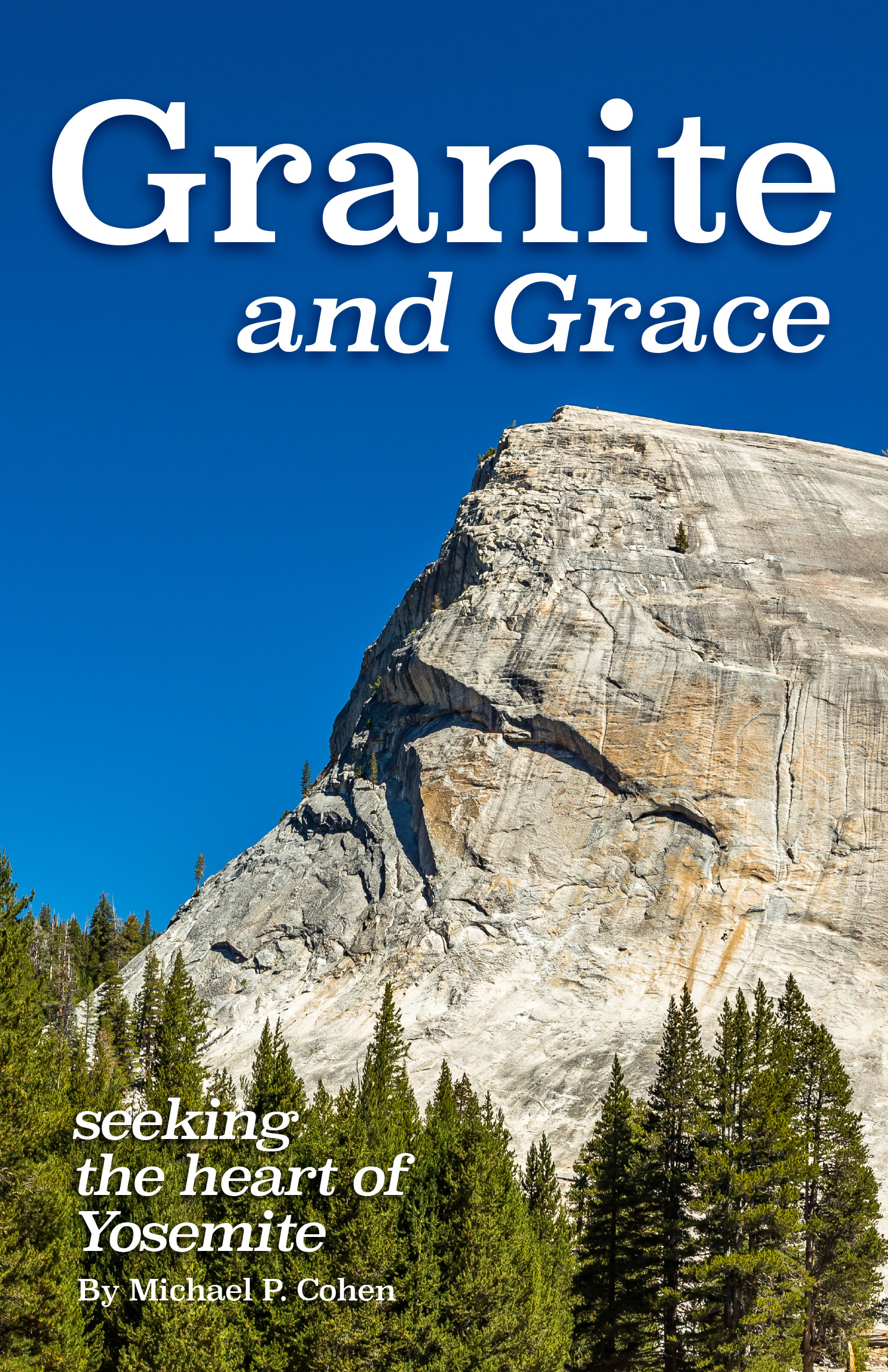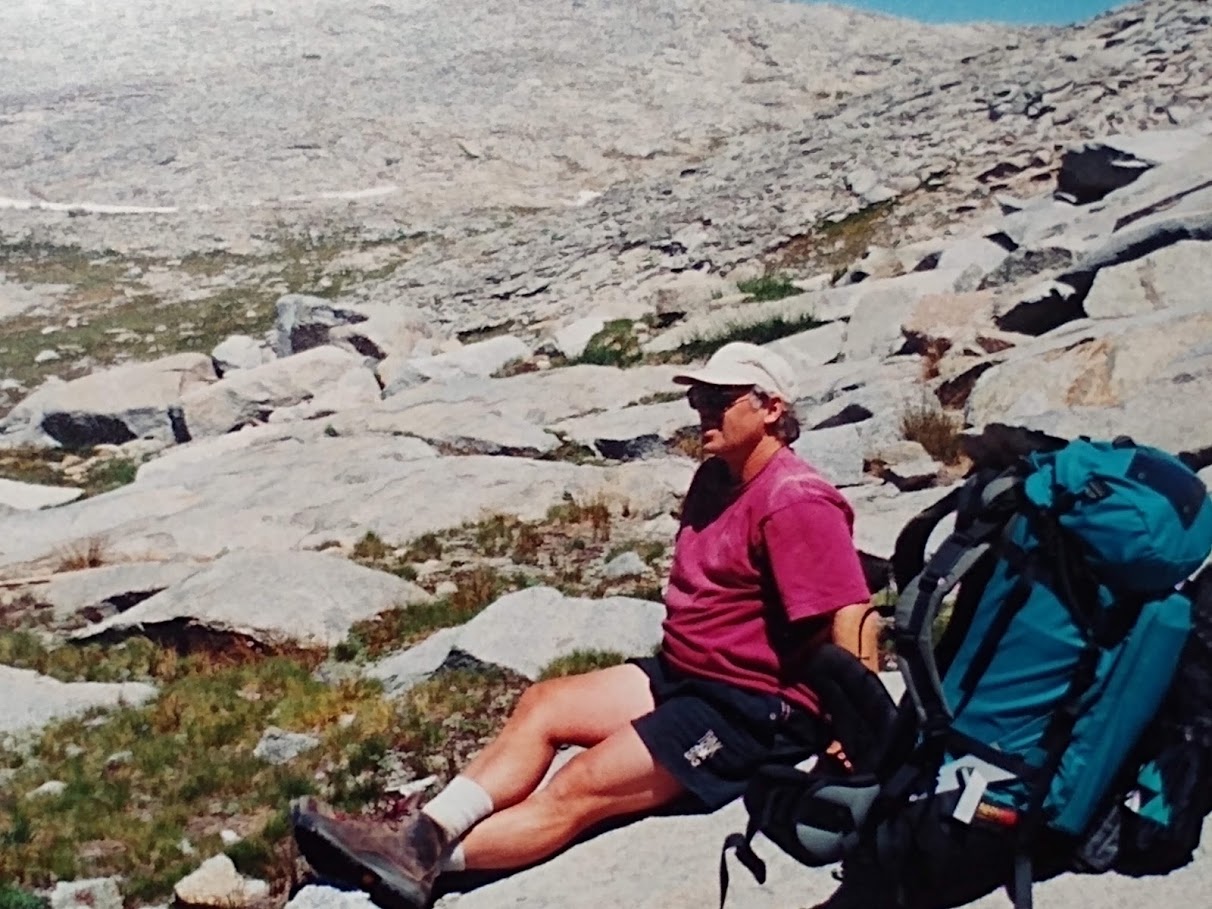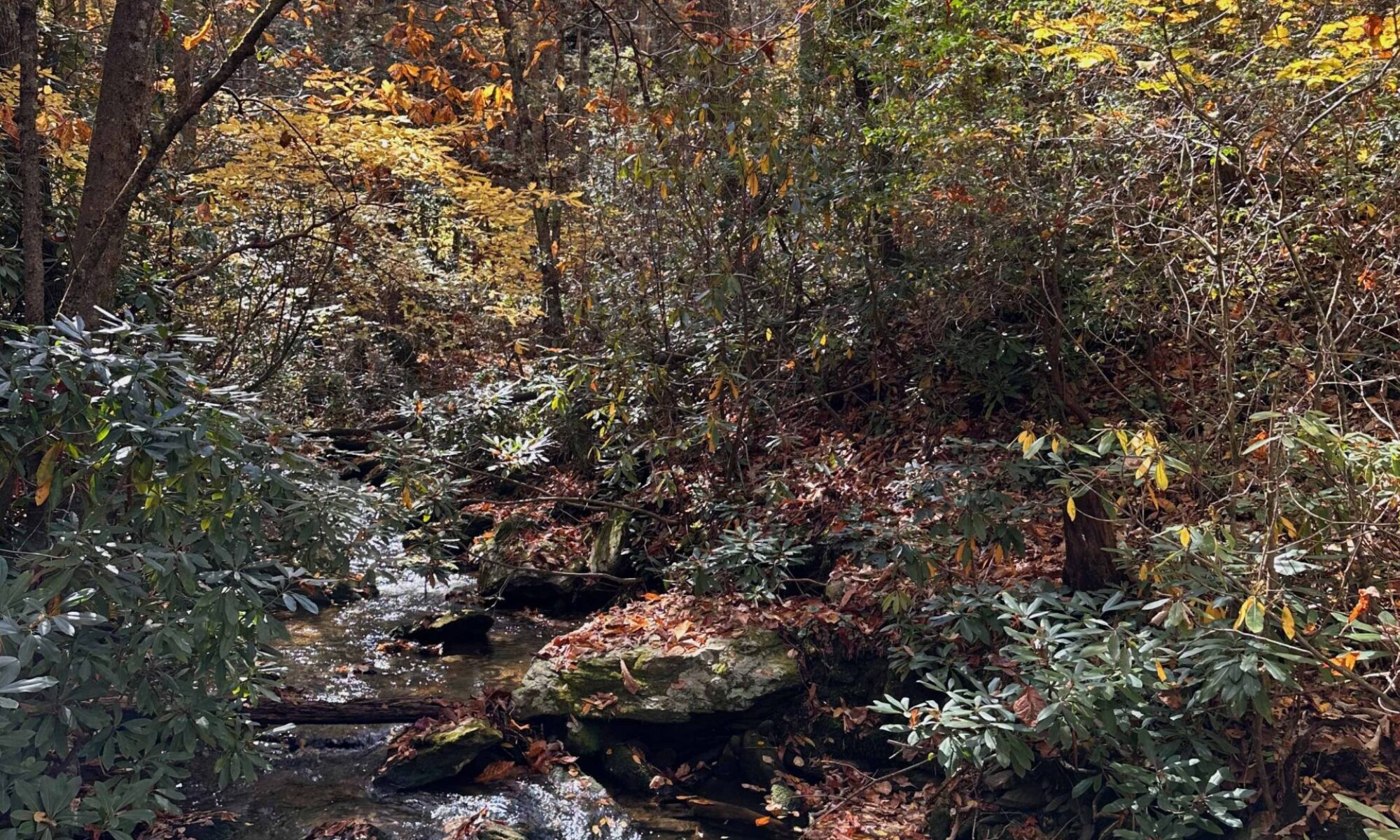
Michael P. Cohen, Granite and Grace: Seeking the Heart of Yosemite (Reno: University of Nevada, 2019), 220 pages. A few hand drawn maps and line drawings at the top of each chapter by Valerie Cohen.
When most people think of Yosemite, they think of the valley with its huge waterfalls and sheer-faced granite cliffs where, at night, you can see the flashlights of climbers’ bivouac in hammocks slung along the rock walls. But there is another side of Yosemite. This part of the park is high above the valley and surrounds Tuolumne Meadows. The top of the park is also granite, mostly sculptured by glaciers. It is here, in a series of essays, that Cohen focuses his study of the rock that made the park so famous. For nearly three decades, Cohen taught at Southern Utah University. During the summer, he and his wife would leave the sandstone of the Colorado River Plateau for June Lake, on the backside of Yosemite. The two of them have been coming to Yosemite since childhood. Early in their life together, Michael worked as a climbing guide in the park while Valerie worked as a summer ranger. Now in his 70s and no longer climbing the steep pitches, Cohen reflects on a lifetime living around Yosemite.
Granite and Grace centers around a series of essays that are often told from the point of view of a walker/hiker/climber in Yosemite. As Cohen recounts walks and climbs, he branches out to discuss various rock formations. Within these essays, he covers the geology of granite, how it was formed under the earth and is often found at the edge of continents. He writes about how the science around granite has changed especially within increase understanding of plate tectonics. He discussed the makeup of granite and why it’s appreciated by builders and climbers for its toughness. I had to laugh in appreciation of Cohen’s fondness for granite as he speaks of eating many meals upon it, but not wanting it as a countertop. (Granite does contain some radioactive minerals and houses built on granite have to be carefully constructed to avoid radon gas buildup). The reader will learn the role of ice in shaping the granite found in Yosemite’s high country. Weaving into his personal quests and the science behind granite, Cohen draws from a variety of literary sources. He quotes authors like John Muir and Jack Kerouac, poets such as Gary Snyder and Robinson Jeffers, and recalls songs from Paul Simon and Jefferson Airplane. While the book is part memoir that mixes in geology and literary interests, at its deepest, it is a philosophical exploration of an individual trying to understand a small section of the world.
In the concluding paragraph of the last chapter before the epilogue, Cohen writes a lyrical paragraph about granite’s “otherness and freedom.” His opening sentence, “I am attracted to granite and intimidated—especially by its textures—precisely because it is not flesh,” sets the stage for reflecting on how the “otherness” of this rock that doesn’t care or care if you care can provide a sense of peace. I was reminded of the last line in Norman McLean’s novella, A River Runs Through It. While Mclean finds peace at being in the river’s waters that gathers all that is, Cohen finds peace in that seemingly solid rock which is totally foreign and indifferent. Both views, I think, are valuable in our understanding the complexity of the human experience.
I recommend this book for anyone wanting to know more about Yosemite (this is not stuff you’ll find in guidebooks). There is something for most everyone in these pages. If you’re curious about geology, there are insights. If you want to know who we relate to the world in which we find ourselves, you’ll find parts that will speak to you.. Cohen is a deep thinker who searches for the precise word to describe his thoughts. In reading the book, if you’re like me, you’ll pull out the dictionary (or google) to look up many of his words. And, if you’re also like me, you’ll want to go back to Yosemite. His description of the Dana Plateau (which was an island above the impact of glaciation) made me realize there are places I still need to explore.
I was given a copy of this book by the author (see below) but was not compelled to write a review. This is the fourth book I’ve read by Cohen.

A Personal Note: My first visit to Yosemite was in 1985, thirty years after Cohen’s first visit. I had flown to San Francisco where my girlfriend at the time was in grad school. We drove to Yosemite for a few days. I was amazed as we snaked up the road that parallels the Merced River. By the time we got into the park, I had used up all my film and had to buy expensive film in a park store to continue photographing the amazing sights. It was between Thanksgiving and Christmas and was snowing. The next morning, while my girlfriend spent the day inside the cozy cabin reading and preparing for exams, I laced up my boots headed out at daybreak. I hiked up toward Nevada Falls. It was amazing (I again ran out of film). Along the way, I met a hiker with a loaded pack. He had skis and crampons strapped to his pack that was filled with winter camping gear and provisions. He was heading up over the top to Tuolumne Meadows where he planned to ski along the highway and down Tioga Pass to Lee Vining. There, he was going to be picked up three days later. I was intrigued. Tuolumne Meadows was beckoning me like Eden.
I have been back to the park a half-dozen times since 1985 and, with one exception, I have always come into the park from the east, into Tuolumne Meadows. When another guy and I completed our hike of the John Muir Trail, Michael Cohen (the author) joined us near Devil Post Pile. As I was living in Cedar City at the time, I had gotten to know Cohen when I audited his class on creative non-fiction. Michael hiked with us for several days as we made our way down Lyell Canyon and into the Meadows. Wanting to avoid the crowds of Yosemite Valley, Michael’s wife Valerie picked him there, while the two of us continued on for another two nights into the valley. When most people think of the park, they think of Yosemite Valley with its huge waterfalls, sheer granite cliffs, and hordes of tourist. Few make it over to Tuolumne Meadows. Cohen’s book will help those who only travel through the valley understand what they missed in the high country.
Michael also appears in another book I reviewed in this blog, Rebecca Solnit’s Wanderlust: A History of Walking.

Alice Outwater, Water: A Natural History (New York: Basic Books, 1996) 212 pages with index and notes. Line drawings by Billy Brauer.
In this collection of what seems to be independent essays, the author describes the history and evolution of water in North America. She begins with the fur trade and nature’s engineers, the beaver. In subsequent chapters, she writes about prairie dogs, buffaloes, alligators, freshwater shellfish, as well as the forests and grasslands. She explores the path of rainfall and how its been altered as we have altered the environment. She discusses the role of the toilet and sewer systems. Toward the end of the book (175ff), Outwater brings together all these seemingly diverse ideas as she discusses our attempts to “save the environment.” She points out the fallacy in many environmental efforts. We attempt to preserve an “endangered species… as if they were items in a catalog… [while] missing the larger ecological picture.” (181). At first, I was wondering where Outwater was going with these essays as they seemed to be independent of one another, but by the end of the book, I understood her point. She encourages us to see how the natural work really does work together.
Water: A Natural History is really a history of human impact upon the waters of North America (mainly the United States). Outwater recalls how we have misused our water and are now changing our views and our behavior as we strive to clean up our rivers and streams. She appears optimistic even while acknowledging there is more to be done. And example of her optimism is from seeing how the non-native zebra mussel, which was introduced by an ocean-going ship into the Great Lakes, is taking over the role of native mussels that have been wiped out by human activity. Having lived in the Great Lakes region for a decade, I know her view isn’t shared by many who see the zebra mussel as problematic.
Much of the concluding chapters of this book comes from Outwater’s work as an environmental engineer in the Boston Harbor cleanup project. Her writing is clear and concise. She caused me to ponder much about water and how we depend on it. I would recommend this book to anyone interested in one of things necessary for life—water. And I also find her name, “Outwater” to be appropriate for someone who writes on the topic! This is my second book by Outwater. I had previously reviewed her book, Wild at Heart which also covers many of these same themes.

I think I’ve been to Yosemite twice. I was a kid for both trips, so it kind of blurs together with other places I’ve camped. I’d love to go back.
You’ve spent a lot of time in the most beautiful parts of our land – including my fine coast. I’m inspired by how well you live.
Have a thoroughly adventurous, safe, and enjoyable holiday weekend, Jeff.
Robyn, I hope you, too, had a nice 4th. And yes, I have been blessed in life to visit many wonderful places.
Both of these books sound interesting. I’ve never been to Yosemite, but it always sounds so lovely. Maybe someday.
I hope you get a chance to visit this unique park, Connie!
Yosemite would be a lovely place to visit and experience.
You should set one of your disaster stories there, Chrys!
I’ve never been to Yosemite but I’ve always liked looking at the pictures of the place.
It’s less than a days drive from Vegas! It’s an incredible place.
These both sound like fascinating books. I visited Yosemite many years agon on a family holiday in California, and I still have very clear memories of some of the landscape there. There’s a lot of granite in Scotland too.
Yes, you’re right about granite and Scotland-you live in a beautiful country!
Yosemite has been on my short list for years and this only increases my longing. Oh how I miss travel!
May we soon be able to travel. And if you get to Yosemite, you’ll have to check out the back country!
Water, A Natural History sounds interesting. I’ve never been to Yosemite but it’s on my very long list of places I’d like to visit.
Water is important and the book gives us an interesting perspective as to our relationship with water.
I may very well check these out. I love hiking/climbing narratives. I am somewhat held back in the hobby by a paralyzing fear of heights – all the more reason to enjoy the adventures of others.
Have you read “Into Thin Air.” I don’t mind heights, but am less adventurous than when I was younger, but when I read “Into Thin Air” which is about climbing Everest, I found myself taking deeper breaths as the author discussed the lack of oxygen.
I have watched on television about the nature of Yosemite.
The book you are reviewing seems to explain in more detail what is in Yosemite. I will read the book.
Thank you for your review.Jeff.
Greetings
Let us know what you think of the book, Himawan!
Yosemite must be so beautiful!Have a lovely day ☺
It is one of the most beautiful places I’ve been, and I’ve been around the globe.
Both books sounds interesting 🙂
They both are interesting! I hope you get a chance to read them.
Never thought much about Yosemite until I saw the Ken Burns documentary on the National Parks. I was just on the wrong side of the country for it to be an interest.
Now I want to see it very badly. I’d also want to see the California coast and travel into Oregon.
The West is an amazing place. The John Muir Trail runs from the top of Whitney to Yosemite and spends most of its time in National Parks (Kings Canyon, Sequoia, and Yosemite. The coastline is also nice, but I have only done a few hundred miles of it and never made it to the coast of Oregon.
I went to Yosemite with my then-fiance back in 2002. What a trip. We only had a few hours in the valley to hike, but it was beautiful. I remember, with amusement, that as the trail got steeper and steeper, my vertigo went into high gear and I had to sit on the trail and scoot back down on my rear like a two-year old on a staircase. Good times!
I’d love to go back and hike in other, less-traveled areas. The book sounds wonderful.
I hope you get back and don’t have vertigo. If you frequently suffer from it, I recommend you not go up half dome!
I have never been to Yosemite, but it’s on my bucket list. My oldest daughter spent part of her honeymoon there.
I hope you get to Yosemite–it’s beautiful!
I couldn’t even read all the way through your review, Jeff, before I raced to Amazon and ordered “Granite and Grace.” I love granite and I love Yosemite. Thanks for giving me a heads up on my post today. And did I say I love glaciers ~ LOL! I dearly want to go back to Yosemite. I haven’t been to Tuolumne Meadows, but I had a friend who loved it and I’ve seen many photos of it. Don’t you love memory cards? I no longer run out of film, and I can experiment with all kinds of shots and photograph anything I want. One of my favorite science fiction books is “The Forge of God,” a 1987 by Greg Bear. Part of the novel is set in Yosemite, and for me it is unforgettable. When did you live in Cedar City? I was closely connected to Cedar City in the late 1970s-1980. I no longer recognize it because it has metastasized.
I lived in Cedar from 1993 to early 2004. It was a wonderful experienced–loved it. I was privileged to lead the Presbyterians through a relocation as we moved from a 1/2 acre lot by Lin’s Grocery to a 5 acre site just north of Fiddler’s Canyon near the north interchange with I15, but that has all changed since I left.
You were there a long time, Jeff! I actually stayed in Enoch which was just to the northeast. I probably saw the old Lin Market on Main Street. I came back to read your other review which I missed in my excitement over “Granite and Grace.” I think I would really like the water book too. I took a course on hydrology, and for most of my teaching career I had great fun teaching my kiddos about the water cycle and how water is foundational to an ecosystem. And many times I took my kiddos on a field trip to the water treatment plant about a mile from our school. Most of the field trips that went there were high school students, so the plant’s workers had lots of fun with my second and third graders. You’ve broken my book budget ~ LOL!
Sorry about that, Louise. But my book budget is always overdrawn! I knew Enoch, well. I spent a lot of time hiking in canyons and skiing up on the mountain when I lived there. The author of the book taught at SUU for nearly 3 decades.
Thanks for the book reviews. They sound great and I am especially intrigued by Granite and Grace. The wife and I have Yosemite on our list of places to see before it’s too late. Even more so after reading your personal note.
I hope you get to Yosemite–it is amazing, but then again is the back country of the Great Basin that you’d travel through on your way down. And, if you took the direct path from Idaho, you’d come in from the backside, which has its advantage (but is only open in the summer).
I love books about nature’s affect on the land and us. These both sound good, Jeff.
Cohen’s book will (unless you’re a geologist) expand your vocabulary. I really should have added a third book on air (to have covered the three “elements”)
The book on water intrigues me the most of these two. And yes, how interesting (and appropriate) that the author’s name is Outwater!
The title makes me think of my mom yelling to us when a cloud was coming up, “Get out of the water”